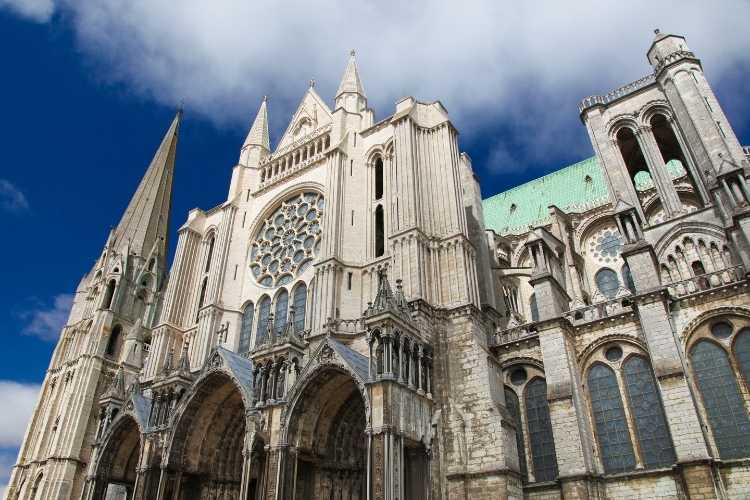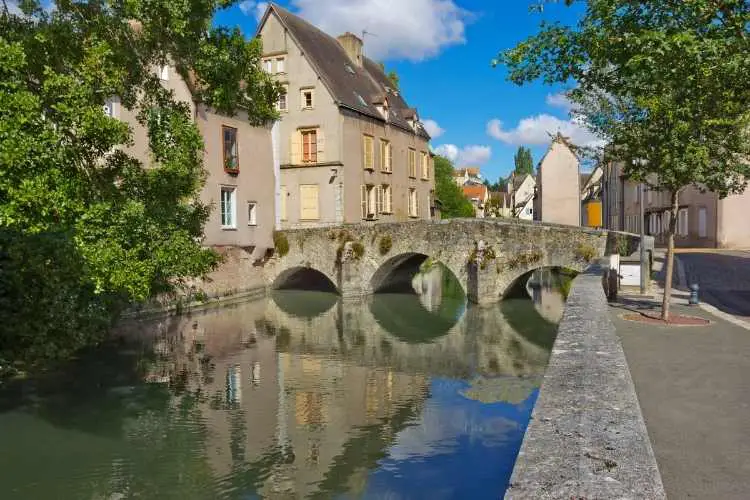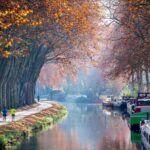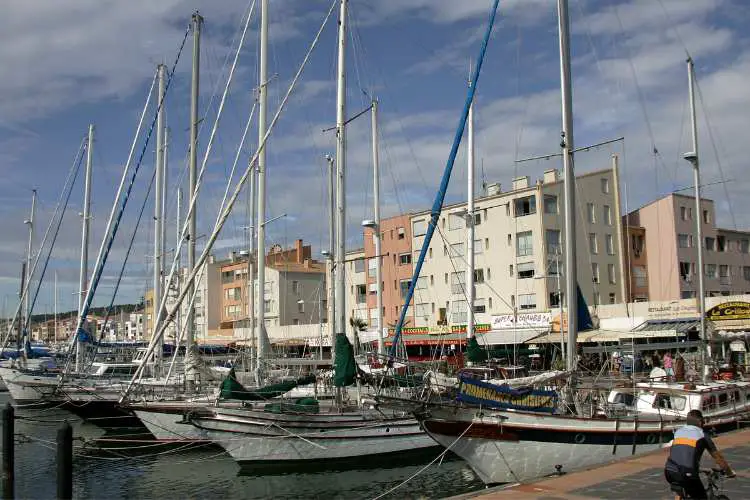Chartres, one of the first urban conservation sites in France, is very much a success story and a must-visit place to see for any tourist ebjoying a vacation in France.
Its quirky cobbled streets and half-timbered houses are wonderfully evocative of a by gone age. There are also steep lanes (tertres) that lead down to the river linking the high and the low towns, humpback stone bridges and numerous public washhouses.
These lavoirs are where, until the middle of the 20th century, women did their washing, using a pulley system that raised or lowered the scrubbing boards dependent upon the height of the river.
Like many famous French cities, Chartres is best-known for its cathedral.Yet in spite of the world renown of its cathedral, Chartres is a delightfully unpretentious place.
It’s located in the largely unknown Eure-et-Loir department. It is the most northerly of the départements of the Région Centre, yet it has much in common with Normandy, Ile de France and the adjacent Loire Valley and and Loir.
It is all very relaxing, unassuming and welcoming, an ideal place to spend an agreeable few days, almost off the beaten track.
The modern town of Chartres
In complete contrast, the modern town is typically boulevard France with busy shops, pavement cafés, restaurants, living statues, markets and the occasional iron pissoir (gents only, of course).
Along the Boulevard de la Résistance stands an impressive memorial to Jean Moulin, hero of the French Resistance during the second World War. He was Prefect of Eure-et-Loir when the Nazis occupied Chartres in 1940.
Under torture he refused to sign papers alleging atrocities of the French Army, and after his release was responsible for organising the French Resistance, and, as ‘Max’, became a legendary figure. He was arrested by the Gestapo in 1943, and died at the hands of Klaus Barbie.
Chartres Cathedral – Notre-Dame
Chartres’ Notre-Dame Cathedral, a symbol of the influence of the town and Christianity, was constructed in the 13th century. Its famous stained-glass windows cover an area of 2,500m². The maze inside the cathedral is one of the biggest in the world (261 metres).
From whichever direction you approach Chartres, it is the two steepled bell towers of the cathedral, one ornate, built in Flamboyant Gothic style in the 16th century, the other, Romanesque, quite plain by comparison, soaring high above the Beauce Plain that first proclaim the whereabouts of the city.

By cathedral-building standards, Chartres was something of a rush job, being substantially completed within less than thirty years, after a fire in 1194 had destroyed most of the city.
For latter-day visitors and architects alike, the most significant consequence of this TGV-like workmanship is a cathedral that is architecturally both coherent and harmonious, the finest example of the Gothic style in the world, and an inspiration to the church builders who followed.
No mean feat considering the many wars and countless religious upheavals that took place in France during the last millennium. It was inscribed as a World Heritage Site in 1979.
Things to do in Chartres
Gradually, the cathedral, floating in a distant haze, materialises above fields of golden wheat or sunflowers, its position on a hill above both the town and the River Eure, becoming clearer little by little.
But not until the last moment, or so it seems, does the town itself materialise, spread about the cathedral in a haphazard mosaic of pan-tiled roofs, pinnacles, half-timbered houses and limestone walls that crowd the narrow lanes leading down to the river.

Place de la Poissonnerie [fishmongers’ square] still has a group of very beautiful buildings including the Maison du Saumon [Salmon House] and the Maison de la Truie [Sow House] close by. This district is known to be where fish were sold from the beginning of the 15th century; the last stall disappeared after 1950.
Close by the market, the rue des Grenets (named after an old Chartres family) leads into the rue des Changes, where, from the 11th until the 15th century, money-changers stood at benches, their place of business.
Read our Guide to French Markets
‘Bench’ in French is ‘banc’, the origin of the word ‘bank’, and so the money people became known as ‘banquiers’, or as we call them now, ‘bankers’.
Today, this is the site of the Saturday livestock market, a buzzing, bustling, rambunctious place where geese and people meet, and rabbits hang beside unplucked pheasants.
The street names are a clue to the busy commercial past of Chartres: the rue de la Poissonnerie leads to the site of the former fish market at the Tertre de la Poissonnerie, and the lovely 16th-century, half-timbered Maison du Saumon also known as the Maison de la Truie qui File (the House of the Spinning Sow).
The building is decorated with wood carvings that are ornate and skilfully executed – a salmon, a pig, angels, vines, butterflies and birds. The rue de la Petite Cordonnerie (Shoemaker’s Street) and the rue aux Herbes (Herb Street) lead back to the cathedral square, and a building that cannot be ignored.
Museums in Chartres
Chartres is known for many things including its amazing cathedral. But in a city where culture and heritage are so rich, it is no wonder that there are so many museums.
Many exhibitions are family friendly and have activities for the kids so there really is something for every taste.
The Musee des Beaux Arts is located behind the cathedral and has been standing since the 12th century when it once served as accommodation for bishops. Now a fine art museum, it’s home to some incredible pieces including several religious paintings and sculptures.
The Musee des Sciences Naturelles at Prehistoire has a wonderful display of more than 200 animal and bird species from around the region.
There are also insect collections that have been curated from five of the seven continents and this is a great place for kids to start their discovery of natural science over the aeons.
Maison de l’Archeologie is an exceptional museum where you will find several exhibitions particularly from the Roman influence over the city.
The museum has been open since the late 1970s and there are lots of things for those new to archaeology as well as plenty of activities to keep the little ones educated and interested.
The Centre National du Vitrail is one of the most unique museums in the Chartres area and is home to a wonderful collection of stained glass.
Most of the pieces on show here date back to the Middle Ages although there are lots of more contemporary pieces to discover. Not only are the displays a sight to behold but they’re set inside a listed building that has been standing since the 1300s!
The walled city of Chartres
From the terrace behind the Episcopal Palace the way through a tiered garden leads to a doorway giving onto the Tertre St Nicholas.
A short distance away is the steep-sloping rue Chantault in which number 29, the Maison Romane, is the oldest inhabited house in Chartres, dating from the 12th century, its windows decorated with curious Romanesque sculptures depicting heads, acrobats, monsters and demons.
Across the river, the rue de la Tannerie leads to the rue du Bourg, where you cross the Pont Bouju – one of the traditional entry points to the walled city – and on to the rue des Ecuyers (the street of the Equeries).
Here are some fine 15th- and 16th-century houses, one, number 25, is the Maison de l’Escalier de la Reine Berthe, a house with a remarkable external spiral staircase, though there is no link between the 11th-century wife of King Robert II, and this 16th-century house.
Parc Des Bords de L’Eure in Chartres
When summer comes around, Chartres is warm, sunny and pleasant so what better way to spend part of your visit than exploring one of the town’s most beautiful parks? The Parc des Bords de l’Eure is much more than just a beautiful outdoor area, although the scenery here is more than pleasing on the eye.
The Parc des Bords de l’Eure is home to plenty of activities for people of all ages and makes the perfect family afternoon out.
For example, there are two wonderful kid’s play areas with lots to keep the little ones entertained as well as a shady picnic area where you can sit back, relax and watch the world go by while you indulge in a long lunch.
If you and your children are animal lovers then the Parc des Bords de l’Eure has something that’s sure to be a hit. The small zoo here is open to visitors and houses a selection of creatures including goats, rabbits and pigs, all of which you can feed. There are also a wide range of birds and fowl here both in the enclosures and living wild on the banks of the river.
One of the main attractions of the Parc des Bords de l’Eure are the river cruises. Sitting on the l’Eure river, visitors have ample opportunities to explore the river in a way that suits them. You can hire a pedalo, canoe or even a mini boat for the day in an area that is fondly known as La Petite Venise. Or Little Venice, in English.
You’ll also find a mini golf area as well as a selection of cafes and snack shops where you can give yourself an energy boost before discovering more of what this excellent park has to offer.






